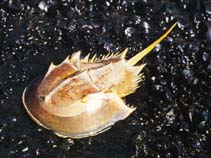
|
Limulus polyphemus (Linnaeus, 1758) Horseshoe crab |

|
|
photo by
Harvey-Clark, Chris |
| Family: | Limulidae () | |||
| Max. size: | 60 cm TL (male/unsexed); max.weight: 1,814.4 g; max. reported age: 20 years | |||
| Environment: | benthic; marine; depth range 3 - 11 m | |||
| Distribution: | Western Atlantic: from Maine, USA to Mexico. | |||
| Diagnosis: | ||||
| Biology: | The males are approximately 1/3 the size of the females (sexual dimorphism) (Ref. 83). Lives in shallow waters, with sandy or muddy bottoms (Ref. 76). Found in intertidal and offshore areas (Ref. 1131). The horseshoe crab feeds at night on polychaete worms such as Cerebratulus, Nereis, and Cistenides (Ref. 76, 77), small mollusks, and seaweed (algae) found in the sandy ocean bottom (Ref. 76). Food is picked up by the chelicerae and passed back to the bristle bases, where it is "chewed." The food is then moved forward to the mouth (Ref. 75). It digs its food from sediments, grasping the prey with its legs. The prey is moved to the gnathobases where it is crushed before being pushed forward toward the mouth (Ref. 77). A life span of about 20 to 40 years (Ref. 78). Its predators are loggerhead turtles, pufferfish, leopard sharks and sea gulls (Ref. 82). | |||
| IUCN Red List Status: | Vulnerable (VU); Date assessed: 17 February 2016 (A3bd) Ref. 123251) | |||
| Threat to humans: | harmless | |||
| Country info: |
|
|||